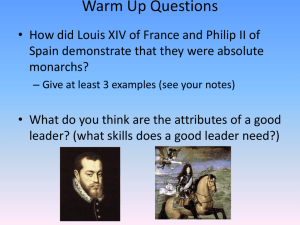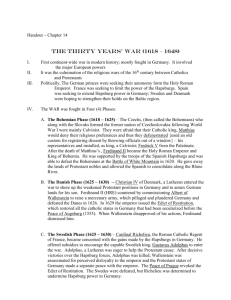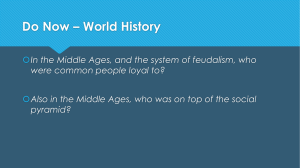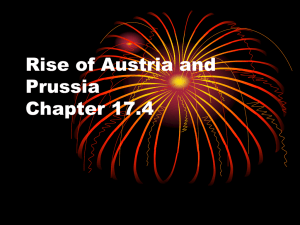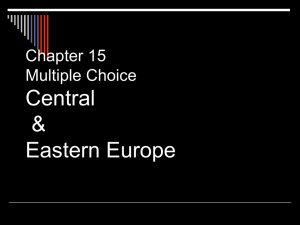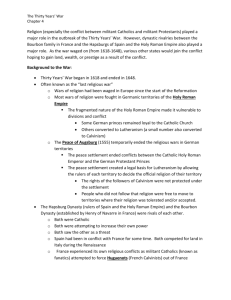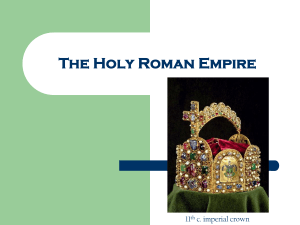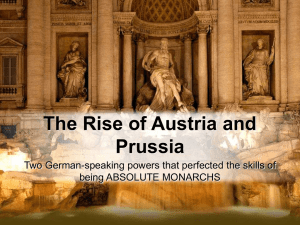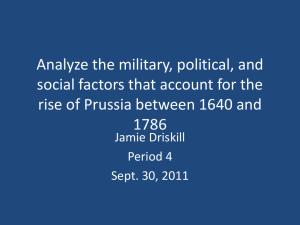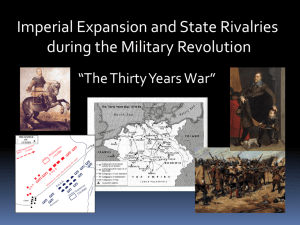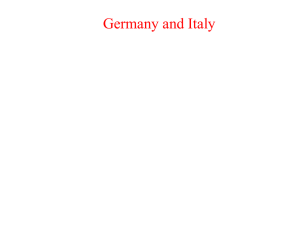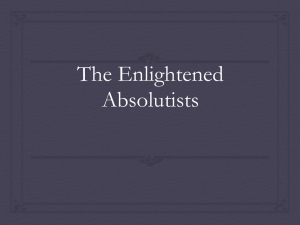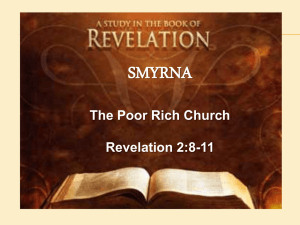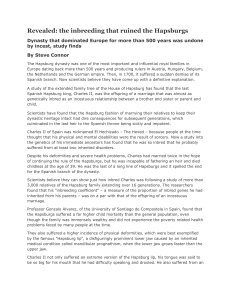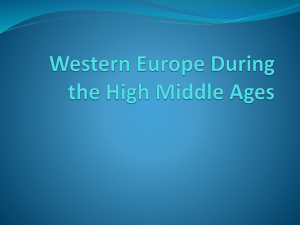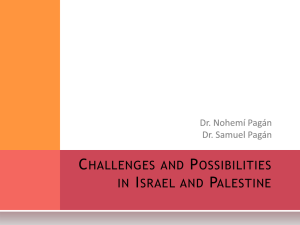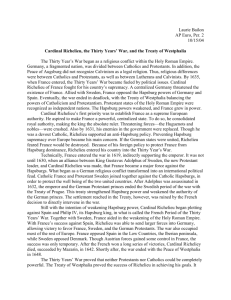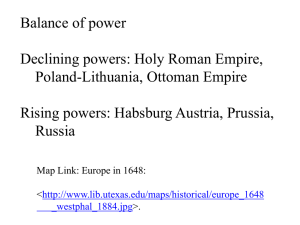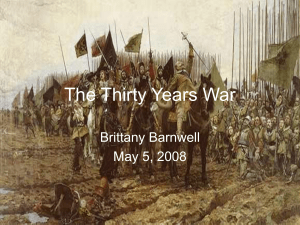Rise Of Austria and Prussia
advertisement
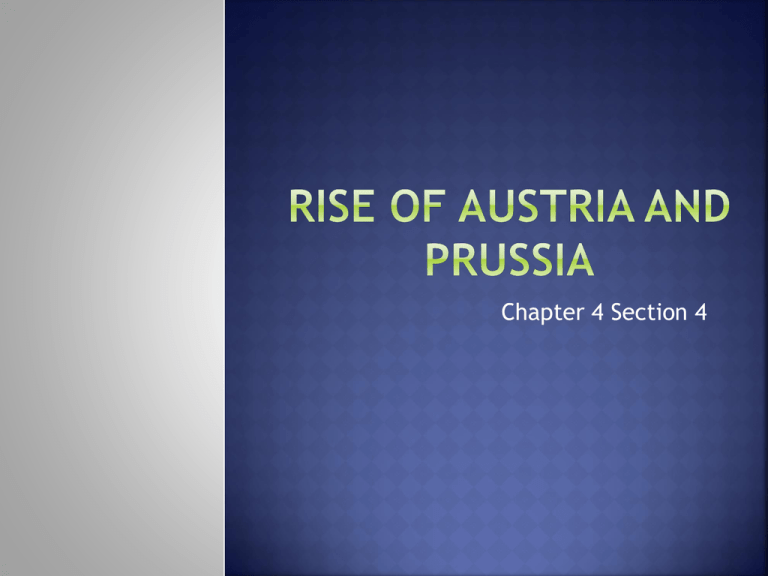
Chapter 4 Section 4 Voltaire, a French philosopher, said that the Holy Roman Empire was a patchwork of several hundred small, separate states. In theory, these states were under control of the Holy roman Emperor He was chosen by seven German princes called electors. In practice, the emperor had little power over the many rival princes. Religion further divided the German states, and this sparked the Thirty Years’ War. War had both religious and political causes. Began in Bohemia, presently the Czech Republic Ferdinand, Hapsburg king of Bohemia, sought to suppress Protestants and assert royal power over local nobles. In May 1618, a few Protestant nobleman tossed two royal officials out of a castle window. This started a general conflict, which turned into a general European War. The following year, Ferdinand was named the Holy Roman Emperor. He tried to roll back the Reformation, with the support of Spain, Poland, and many Catholic States. Early on in the war, he defeated the Bohemians and their Protestant Allies Immediately after, Protestant Powers such as Netherlands and Sweden sent troops to Germany. Political Issues quickly outweighed religious issues, and many rulers shifted their alliances to suit their interests. Eventually, Catholic France joined Lutheran Sweden against the Catholic Hapsburgs. Armies of mercenaries, or soldiers for hire, burned villages, destroyed crops, and killed without mercy. Murder and torture were followed by famine and disease. The war led to depopulation, or reduction of population. Historians estimate that one third of the people in German states died from the war. In 1648, the sides accepted a series of treaties, known as the Peace of Westphalia. France came out as a clear winner. They gained territory on both it German and Spanish Frontiers. The Hapsburgs were the losers because they had to accept the total independence of all the princes of the Holy Roman Empire. Netherlands and Switzerland won recognition as independent states. Germany ended up divided into 360 separate states. They still acknowledged leadership of the Holy roman emperor. Each state had its own coinage, government, armed forces, state church, and foreign policy. Germany remained fragmented for another 200 years. Weakened by war, Hapsburgs wanted to create a strong united state. Kept title of Holy Roman emperors. Along with Austria, they added Bohemia, Hungary, and parts of Italy and Poland. Uniting the lands were very difficult. In the Hapsburg Empire, people had their own languages, laws, assemblies, and customs. The Hapsburgs did exert control over these diverse peoples. The Hapsburg Empire never developed a centralized government. In 1700s, emperor Charles VI had no son to take his place as ruler. His daughter, Maria Theresa, was capable, but no woman had ever ruled Hapsburg lands. Charles asked many rulers to recognize his daughter’s right to succeed him, but many ignored their pledge. In 1740, Frederick II of Prussia seized control of a Hapsburg province. Maria asked Hungarians for military help, but they were unfriendly with her. She eventually got help from Britain and Russia. Throughout the war, she strengthened Hapsburg power by reorganizing the bureaucracy and improving tax collection. Prussia emerged as a new Protestant power In 1600s, the Hohenzollern family ruled parts of north Germany. They eventually conquered many other states and they set up a central bureaucracy and reduced independence of nobles, called Junkers. Many Prussian rulers formed one of the best trained armies in Europe. They won loyalty of Junkers by giving them positions in government or army. Frederick William trained his son Frederick II in the art of war Frederick II preferred playing the flute and writing poetry. His dad treated him terribly because of this, and Fred JR. tried to flee the country Finding out about this, Frederick William put his son in solitary confinement. Shortly after becoming king, Fred Jr. used his army to seize Silesia from Austria. In many other wars, Fred Jr. brilliantly used his army, forcing all to accept Prussia as a great power. This is how he became Frederick the Great. By 1750, the great powers of Europe were Austria, Russia, Prussia, France, and England. Formed alliances to maintain balance of power Sometimes, rivalries caused worldwide conflict. Mercenary- Soldier for hire, only fights for the highest bidder Depopulation- Loss of population due to war, famine, or disease What country did the Hapsburg’s rule, actually what country and empire? Austria What was the group of Princes called that selected the Holy Roman Emperor? Electors What did the Holy Roman Emperor want to roll back in Europe? Protestant Reformation/Protestant Tide What was the war called the ended with the Peace of Westphalia? 30 years war Who was the first female empress of Austria? Maria Theresa
